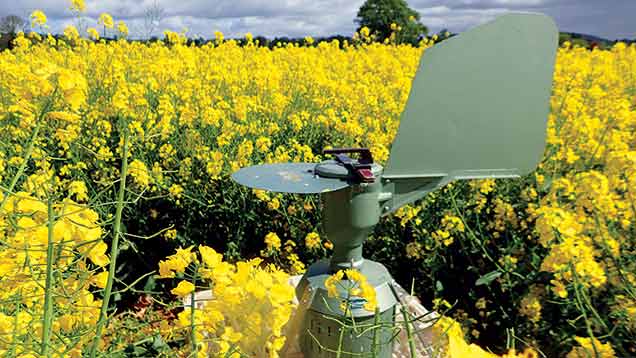Researchers aim to improve disease forecasting in OSR

Deciding when is the best time to apply a flowering oilseed rape fungicide for sclerotinia control can prove difficult. Sarah Henly asks lead researcher Caroline Young how treatment timings may be improved in the future.
Some areas of the UK were at risk from sclerotinia infection last month, but cool nights kept many oilseed rape crops out of danger, believes ADAS’ Caroline Young.
Rainfall in early May allowed many sclerotia to germinate in the soil surrounding oilseed rape crops, producing black upturned mushroom-like fruiting structures called apothecia. These released air-borne spores that were detected in spore traps at four research centres from Devon to South Yorkshire.
See also: Researchers aim to make precision farming pay
However, only where they landed on petals and local conditions were favourable did they give cause for concern, she says. An infection event during the flowering period is defined as 24 hours at or above 7C and relative humidity at or above 80%.
Research reasons
This project should provide a sclerotinia disease risk reporting system, to help guide fungicide timing and reduce yield loss in oilseed rape
Project: Sclerotinia risk live-reporting system for oilseed rape
Timescale: March 2015 – March 2018
Researchers involved: ADAS, Rothamsted Research, University of Warwick, Velcourt and BASF
Funders: HGCA
Cost: £161,400 from HGCA
Key points
Local weather determines risk of sclerotinia infection
Regular updates can warn of imminent infection events
Economics of spraying will be calculated
Predicting whether or not sclerotinia will cause significant disease and subsequent yield loss is a difficult business, so Dr Young is co-ordinating a project to address that. In its early days, it aims to offer guidance to reduce prophylactic spraying against the pathogen.
“In the absence of crop monitoring data, it’s not surprising some growers take in the sprayer during flowering, to protect yields. We hope to provide intelligence to assess if and when you should spray, alerting growers up to 48 hours before they need to act.”
As well as an overall assessment of the sclerotinia risk, HGCA forecasting uses model predictions and information based on crop observations, such as the incidence of petals sticking to leaves and the quantity of airborne inoculum. The approach is different from previous schemes which have only evaluated specific models or risk factors in isolation, she says.
German model
A German-based forecasting model called SkleroPro is being exploited for its information on sclerotinia infection criteria. UK maps with traffic-light colour coding of the onset of sclerotial germination are also helping to pinpoint priority areas.
“We can give live, at least weekly, flowering period alerts on a local level via the HGCA website. BASF is currently monitoring the disease in the crop and also providing updates on its website. The maps will later be supplemented by charts offering additional data such as the economics of treatment.”
Though fungicides are not under investigation in the project, recommended products include boscalid (Filan and in Tectura), azoxystrobin (such as Amistar) or picoxystrobin (eg Galileo). Under high disease pressure, up to 2t/ha can be protected by a well-timed, full-rate treatment, suggests Dr Young.
“One of the big questions for us is to assess when a follow-up is necessary. There’s a stage at which the disease becomes less of a risk or hasn’t time to do much harm. But if you first sprayed at early flowering, where it turned warm you’d have needed to follow up three weeks later if the crop hadn’t finished flowering.”
Characteristic symptoms of infection, in the form of white stem lesions, will become apparent as harvest approaches, defining the scale of the problem across the country. Dr Young is hopeful yield loss to the disease is limited this season, and in future forecasting will reduce it further.
HGCA perspective by Jenna Watts
Research and knowledge transfer manager, HGCA
“Our oilseed rape fungicide performance work shows spray timing during the flowering period is vitally important for good sclerotinia control, since fungicides offer little or no curative activity and they can’t protect crops for the whole infection risk period. We are looking at whether an infection event can be forecast up to 48 hours in advance, to help growers decide if and when to make a targeted fungicide application.”

